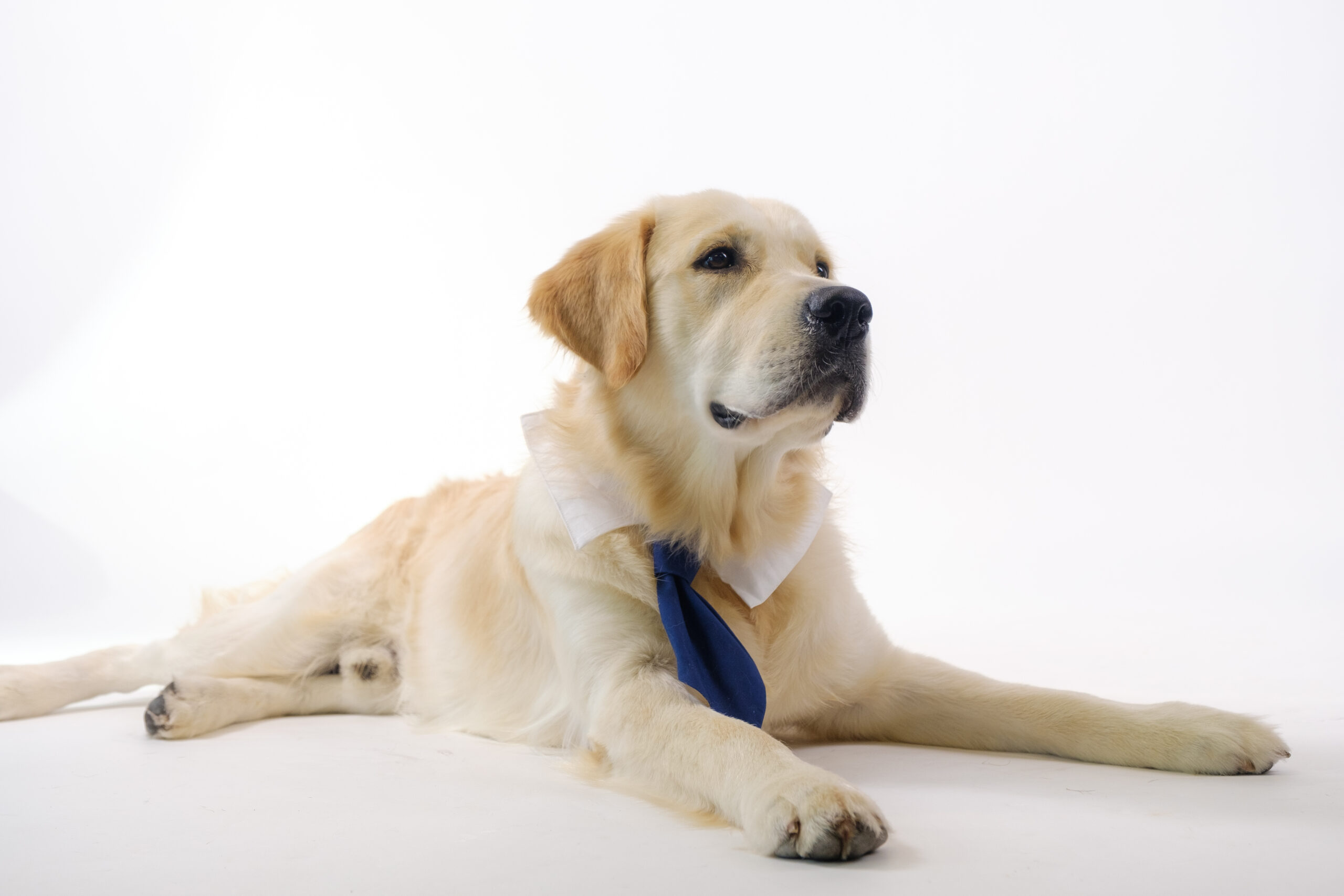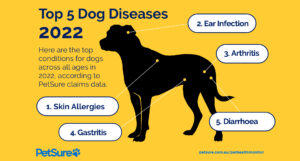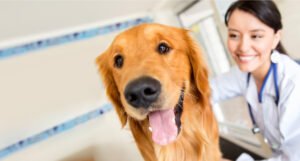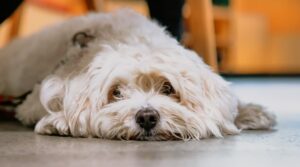Golden Retriever | Traits | training | Typical health problems
The section below outlines a Goldern Retrievers traits, training and typical health problems.
Golden Retriever | Breed highlights
| Breed: | Golden Retrievers are a breed of large, sporting dogs characterised by a gentle personality, intelligence and loyalty. In addition, Golden Retrievers are physically agile, strong and highly trainable. |
| Coat type: | Golden Retrievers have medium to long golden or cream-coloured coats. The fur can be wavy or straight, and this feathers outwards on the tail, belly, and front legs. |
| Shedding: | Golden Retrievers are a moderate-shedding breed (they will moult twice a year: Spring and Autumn) |
| Grooming: | Golden Retrievers need brushing at least once a week to remove excess fur and keep the coat looking good (more often during moulting season). Bathe every few weeks in summer and once every few months in winter. |
| Activity level: | Golden Retrievers are an active breed and require daily exercise. |
| Apartment friendly: | Golden Retrievers generally need an outdoor area to expend energy. |
| Small children: | Golden Retrievers are good-natured and get along well with children (supervision is always recommended). |
| Other dog friendly: | Golden Retrievers are social and play well with other dogs. |
What type of breed is a Golden Retriever?
Golden Retrievers are an energetic and enthusiastic large dog breed. These attributes and their gentle nature make them a popular choice with active families. They are very similar to Labradors in temperament but slightly smaller and furrier. Golden Retrievers are classified as a sporting breed.
History of the Golden Retriever
Golden Retrievers were developed in Scotland as hunting dogs in the early 19th century. The breed’s origins include a mix of water spaniels, bloodhounds, Irish Setters, and Labradors. The role of this breed originally was to fetch water or game birds. A legacy of their breeding means today’s Golden Retriever is happiest in water (noted for being an excellent swimmer) and retrieving an object on command.
Golden Retriever appearance and characteristics
Golden Retrievers are notable for their size, strength and natural good looks. Males stand from 56 to 61 centimetres, while females stand slightly smaller between 51 to 56 centimetres. Healthy adult Golden Retrievers weigh between 25 and 34 kilograms. Golden Retrievers have cream or golden-hued dense fur that feathers along their tail, belly and front legs. The breed is recognisable by its large dark expressive eyes, a pointed, broad muzzle and a large black nose. Ears are set level with their eyes and hang with a slight fold
Golden Retriever personality and temperament
The Golden Retriever is a social, intelligent, and affectionate breed. They are naturally playful and love nothing better than swimming or play a game of fetch – or a game that combines both! With the right training, Golden Retrievers may work as therapy or service dogs or work with search and rescue teams.
Golden Retriever traits
Golden Retrievers are companionable dogs that like the company of people.
Generally, the breed can manage if left alone for shorter periods, although at most four to five hours. Too much time by themselves may result in destructive behaviour.
Aim to provide a setting with plenty of interactive play, exercise and structured training to ensure your Golden Retriever thrives.
Golden Retriever Lifespan
Healthy Golden Retrievers live for 10 to 12 years
The dos and don’ts of caring for a Golden Retriever
Do: Golden Retrievers are a moderately shedding breed, so expect a fair amount of fur to be left behind. Brushing at least once a week will help remove excess hair.
Don’t: Golden Retrievers are double-coated, meaning they have two layers of fur: a fuzzy undercoat and longer hair on top. Clipping for this breed is not recommended; however, the longer feathered fur (this grows around the tail, front paws, belly, and armpits) requires light trimming to make it easier to comb.
Do: Expect a twice-yearly heavy moult. Moulting in spring is to prepare for the hotter summer months, while an autumn moult is to prepare the coat for cooler temperatures.
Manage heavy moulting during season changes with extra brushing. Note: excess hair and fur can trigger dander allergies in sufferers.
Common conditions for Golden Retriever
| Conditions | Symptoms can include~ | Highest cost for a single treatment* |
| Gastrointestinal (tummy) problems | · Diarrhoea, vomiting or constipation. · Blood or mucous in stool/vomit. · Increased frequency/urgency passing stool. · Weight loss. · Loss of appetite and interest in food. · May seem more tired than usual. | $19,500 |
| Traumatic Accidents, including bite injuries, wounds and broken bones | · History of trauma · Wounds, scratches, pus, · bleeding, swelling, heat, pain · Limping, changes to movement. · Behaviour changes. · Broken claws · Pain/tenderness | $10,757 |
| Ear Conditions -including infections and allergies | · Scratching, rubbing, or pawing at one of both ears. · Head shaking · Odour or discharge from the ears · Ears may be red or warm to the touch | $11,063 |
| Skin Conditions, including – infections and allergies | Scratching, biting, or rubbing the skin. · Signs of irritation, including red skin, scabs, bleeding, pustules, or weeping. · Hair loss, flaky skin, texture changes, lumps or an unusual or unpleasant smell. | $9,755 |
| Arthritis | · Limping on an affected limb/s · Stiffness on rising · Reluctance to jump or head up and down stairs · Swelling on pet’s legs | $7,277 |
Disclaimer: Reimbursement for these claims would be subject to limits, such as annual benefit limits or sub-limits, benefit percentage, applicable waiting periods and any applicable excess. Cover is subject to the policy terms and conditions. You should consider the relevant Product Disclosure Statement or policy wording available from the relevant provider.
* Please note that the values calculated are based on all claims for that condition and medically related conditions in each calendar year.
Types of pet insurance from PetSure
| Policy type | Policy description |
| Accidents | This product provides cover for specified accidental injuries up to an annual policy limit. Most policies will reimburse a stated Benefit Percentage that is typically 80% of eligible vet bills. Some condition sub-limits may also apply, with all annual limits resetting each year when the policy is renewed. It’s important to know that only defined accidents as listed in the policy’s Product Disclosure Statement will be covered (other conditions will not be covered). More information on what is typically covered and not covered in our find a policy page. |
| Basic care | This product provides limited cover for both specified accidental injuries and illness conditions, with a stated Benefit Percentage that can range from 60-90%. Treatments and medications for eligible conditions are typically covered subject to the applicable policy limits. Claimable conditions have an annual condition limit , meaning once the condition limit (subject to the annual benefit limit) has been reached in an annual policy period, costs relating to that condition will need to be covered entirely by the policyholder. However, annual benefit limits and applicable annual condition limits reset on renewal each year. More information on what is typically covered and not covered in our find a policy page. |
| Comprehensive / Accident and Illness | This product provides comprehensive cover for both specified accidental injuries and illness conditions, with a stated Benefit Percentage that will typically range from 70-85%. You can claim up to an annual maximum limit each year, which resets on renewal. Sub-limits for certain items may also apply. More information on what is typically covered and not covered in our find a policy page. |
Insurance products are issued by The Hollard Insurance Company Pty Ltd ABN 78 090 584 473, AFSL 241436 (Hollard) and/or PetSure (Australia) Pty Ltd ABN 95 075 949 923, AFSL 420183 (PetSure) (from 8 May 2023 only), administered by PetSure and promoted and distributed through their authorised representatives and distribution partners.
Any advice provided is general only and does not take into account your individual objectives, financial situation or needs. Cover is subject to the policy terms and conditions. Please consider the Product Disclosure Statement (PDS) to ensure this product meets your needs before purchasing, or choosing to continue with the product. PDS and Target Market Determination available on our partners’ websites. Meet our partners at petsure.com.au/partners.
Pet insurance can help by covering a portion of the eligible vet bill if the unexpected happens. Because it is difficult to predict the costs of veterinary care, it can help to have measures in place to help prepare for the unexpected. Check out our partner network and explore our policy tools to find a pet insurance policy.
Not all conditions or items are covered by Pet Insurance. Refer to the applicable Product Disclosure Statement for information about coverage and exclusions.
Frequently Asked Questions
Golden Retrievers are generally healthy, although health problems may arise. These can include:
* Allergies,
* Hip dysplasia,
* Ear infections,
* Cancer,
* Arthritis
* Heart disease.
Golden Retrievers are among the more intelligent dog breeds. It ranks fourth smartest dog breed behind Border Colliers, Poodles and German Shepherds.
Golden Retrievers aren’t a chewing breed, but they do like carrying things around in their mouths (after all, they have been bred to retrieve).
According to PetSure’s Pet Health Monitor it was the second most popular dog breeds born in 2022, according to PetSure policy data.
References
https://www.britannica.com/animal/golden-retriever-dog
Pet insurance can help by covering a portion of the eligible vet bill if the unexpected happens. Because it is difficult to predict the costs of veterinary care, it can help to have measures in place to help prepare for the unexpected. Check out our partner network and explore our policy tools to find a pet insurance policy.
Not all conditions or items are covered by Pet Insurance. Refer to the applicable Product Disclosure Statement for information about coverage and exclusions.



 Fact checked
Fact checked





